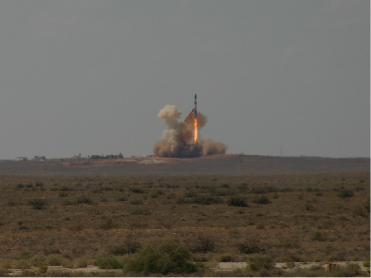
MOSCOW (BNS): RapidEye, the five satellite constellation was successfully sent into orbit by launch vehicle Dnepr from Baikonur in Kazakhstan today.
It was a challenge to take five satellites into their orbit and the special spacecraft bus was build by SSTL in Guildford, UK. The imaging payloads were designed by MDA, contractors of the RapidEye mission with the help of Germany's Jena-Optronik GmbH of Jena.
After the launch, the spacecraft separated from the launch vehicle to place satellites equally distanced from each other within the same orbit set apart by 19 minutes.
"The simultaneous launch of five satellites is not without its challenges. Commissioning will be performed from both the RapidEye ground station in Brandenburg and the SSTL mission control centre in Guildford," said project manager Ben Stocker.
After separation from the launcher, the satellites would be on their own. Three would be tracked and controlled from Brandenburg while others from Guildford. Ben said that this system would offer efficient route to achieve the maximum amount of contact time per satellite during the early days of commissioning following launch.
"As the satellites are gradually manoeuvred into position around the orbit during the commissioning phase, the Brandenburg ground station will assume full control over the constellation," he said.
All the five satellites in RapidEye constellation are small and are meant to monitor earth's surface so that it would provide inputs to farmers, food companies and governments for planning purposes.
The satellite system is meant to image an area in the world at all latitudes between plus or minus 75 degreess within one day and cover the entire agricultural areas of North America and Europe within an average of five days. The spacing of 19 minutes between the satellites will ensure frequent imaging of any particular area.
After the separation, the spacebus would activate three GaAs solar panels to generate 105W sunlight setting off the battery charge management system. The communication with the satellite system would be through the S-band system.
The advantage of focusing on a particular area is that it would become possible to obtain agricultural data like the land information. It would help in mapping and monitoring of crops and contribute in studying natural disasters.
"SSTL long ago established the benefits of small satellite constellations and launched the Disaster Monitoring Constellation in 2002, paving the way for a new paradigm in remote sensing. The launch of RapidEye will fully realise the business potential of constellations.
The simultaneous build of five satellites is the largest mission so far in terms of maximising and managing production at SSTL's Guildford facilities. Expert in-house engineering and project management teams worked closely with MDA, streamlining the design, build and test of all five satellite platforms," said an SSTL official.
 Previous Article
Previous Article













The Indian Air Force, in its flight trials evaluation report submitted before the Defence Ministry l..
view articleAn insight into the Medium Multi-Role Combat Aircraft competition...
view articleSky enthusiasts can now spot the International Space Station (ISS) commanded by Indian-American astr..
view article